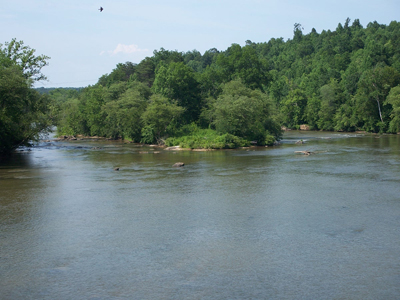Yadkin-Pee Dee River
 Yadkin–Pee Dee River rises as the Yadkin River in Watauga County near the town of Blowing Rock and flows southeast through Caldwell County; it turns northeast and flows through Wilkes County and along the Surry-Yadkin, Davidson-Rowan, Davie-Forsyth, Yadkin-Forsyth, Davie-Davidson County lines, and part of the Montgomery-Stanly County line. It joins the Uwharrie River in Montgomery County to form the Pee Dee River. The Pee Dee River then travels along the Stanly- Montgomery and Anson-Richmond County lines into South Carolina, where it drains into Winyah Bay
Yadkin–Pee Dee River rises as the Yadkin River in Watauga County near the town of Blowing Rock and flows southeast through Caldwell County; it turns northeast and flows through Wilkes County and along the Surry-Yadkin, Davidson-Rowan, Davie-Forsyth, Yadkin-Forsyth, Davie-Davidson County lines, and part of the Montgomery-Stanly County line. It joins the Uwharrie River in Montgomery County to form the Pee Dee River. The Pee Dee River then travels along the Stanly- Montgomery and Anson-Richmond County lines into South Carolina, where it drains into Winyah Bay
The Yadkin River has been the site of human civilization for at least 12,000 years, earning it the nickname of the ‘‘Tigris and Euphrates of the Carolinas.’’ It was formerly called the Sapona River, after the peoples who originally inhabited its banks, until the name was changed between 1709 and 1733. The origin of the word ‘‘Yadkin’’ is unknown; different spellings appeared throughout the eighteenth century, including ‘‘Yatkin,’’ ‘‘Atkin,’’ and ‘‘Reaktin.’’ The name ‘‘Pee Dee’’ probably came from either the Catawba Indian word pi’ri (something good) or pfhere (smart, expert, or capable).
The size of the Yadkin–Pee Dee’s North Carolina watershed is 7,213 square miles, and the river is 435 miles long. There are 81 North Carolina municipalities within its river basin, including Wilkesboro, Salisbury, and Lexington. In the early 2000s the area had a population of more than 1.2 million. The river has experienced various environmental problems, most notably a huge amount of sediment generated by the farmland erosion along its banks. Various soil-conservation plans have begun to solve some of the river’s sediment problems, as scientists continue to study both that issue and others affecting the Yadkin’s water quality and overall health.
Reference:
T. Edward Nickens, "Father Yadkin," Wildlife in North Carolina 63 (November 1999).
Image credit:
Hairr, John. 2011. "The Yadkin River near Rockford in Surry County."
1 January 2006 | Bayley, Elizabeth